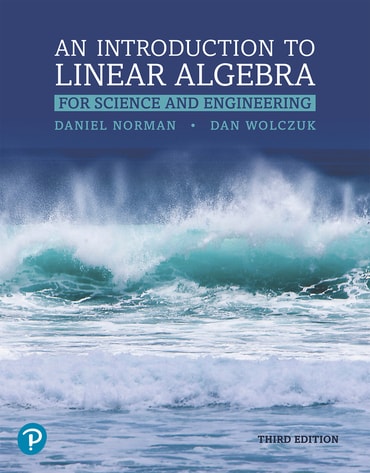
Introduction to Linear Algebra for Science and Engineering, 3rd edition
Published by Pearson Canada (January 18, 2019) © 2025
- Daniel Norman |
- Dan Wolczuk |
Switch content of the page by the Role togglethe content would be changed according to the role
Title overview
For courses in Linear Algebra.
Norman/Wolczuk's An Introduction to Linear Algebra for Science and Engineering has been widely respected for its unique approach, which helps students understand and apply theory and concepts by combining theory with computations and slowly bringing students to the difficult abstract concepts. This approach includes an early treatment of vector spaces and complex topics in a simpler, geometric context. An Introduction to Linear Algebra for Science and Engineering promotes advanced thinking and understanding by encouraging students to make connections between previously learned and new concepts and demonstrates the importance of each topic through applications.
Hallmark features of this title
- The idea of linear mappings is introduced early in a geometrical context, and is used to explain aspects of matrix multiplication, matrix inversion, features of systems of linear equations, and the geometry of eigenvalues and eigenvectors. Geometrical transformations provide intuitively satisfying illustrations of important concepts.
- Topics are ordered to give students a chance to work with concepts in a simpler setting before using them in a much more involved or abstract setting. For example, before reaching the definition of a vector space in Section 4.2, students will have seen the ten vector space axioms and the concepts of linear independence and spanning for three different vectors spaces, and will have had some experience in working with bases and dimensions. Thus, instead of being bombarded with new concepts at the introduction of general vector spaces, students will just be generalizing concepts with which they are already familiar.
- A selection of routine mid-section exercises are provided, with answers included in the back of the book. These allow students to use and test their understanding of one concept before moving onto other concepts in the section.
New and updated features of this title
- Some of the content has been reordered to make even better use of the spacing effect. The spacing effect is a well known and extensively studied effect from psychology, which states that students learn concepts better if they are exposed to the same concept multiple times over spaced intervals as opposed to learning it all at once.
- The number and type of applications has been greatly increased and are used either to motivate the need for certain concepts or definitions in linear algebra, or to demonstrate how some linear algebra concepts are used in applications.
- A greater emphasis has been placed on the geometry of many concepts. In particular, Chapter 1 has been reorganized to focus on the geometry of linear algebra in R2 and R3 before exploring Rn.
Table of contents
- Euclidean Vector Spaces
- Systems of Linear Equations
- Matrices, Linear Mappings, and Inverses
- Vector Spaces
- Determinants
- Eigenvectors and Diagonalization
- Inner Products and Projections
- Symmetric Matrices and Quadratic Forms
- Complex Vector Spaces
